

Xhesika Ruzsa reached out to me, so I audited her website and Google Ads campaign.
Seven years ago, Xhesika and her husband started an epoxy and polished concrete flooring business. She managed all the marketing herself, from Facebook ads to Google Ads. Now, they’ve grown to a team of 15.
Three months ago, Xhesika took a call from the Google help team, and they messed everything up. Now, her campaigns cap out within 2-3 weeks due to budget or bidding issues—something that shouldn’t happen in an optimized campaign. The Google help team is just a group of salespeople trying to get you to spend more. The Google optimization score really means “how much more money Google can make.” They manipulate this score by adding more keywords or pushing for a higher budget. These are sales tactics designed to increase spending.
Before it got messed up, she was spending $2,000 – $3,000 a month, but now it’s up to $5,000 per month, which is a lot for a home service business. So, when something like this happens, I check the change history.
The same happens on Facebook. At Yahoo, we faced the same issue. As a publicly traded company, we needed to boost revenue, so we hired salespeople. We didn’t call them salespeople, though; we labeled them “search engine experts,” “Meta ads experts,” or “Google Ads experts.” But these “experts” often lacked real experience. Xhesika ended up with someone from India, but Google has been hiring fresh college grads from Michigan and elsewhere who have never run a PPC campaign in their life.
They use an internal tool to check your account, much like Google Ads where you get warnings urging you to spend more. It’s frustrating, but that’s capitalism.
Xhesika’s call volume has dropped from 30-40 calls a day to being happy with just 3 now.
I love working with hands-on people because most home service business owners think they need to hire an agency or believe the work is too technical and are afraid to try it themselves.
Google was generating most of her calls, both from her Google Business Profile (GBP) and the ads. She set a $500 budget for her Local Service Ads (LSAs) and then stopped.
To manage these calls effectively, you should mark them within 24 hours. Dispute any bad calls and flag the useful ones. If you forget to do this and get charged for unqualified calls, contact LSA support and request a refund. Explain that you weren’t aware of the dispute process, and they can help.
The beauty is that her ads were working well before the salespeople messed things up.
We began the audit by searching for her website. Before pressing enter, a thumbnail appeared in the search results, showing that Xhesika’s business is recognized in the Knowledge Graph, linking to her Google Business Profile (formerly Google My Business). This is a positive sign and easy to trigger for a local business.
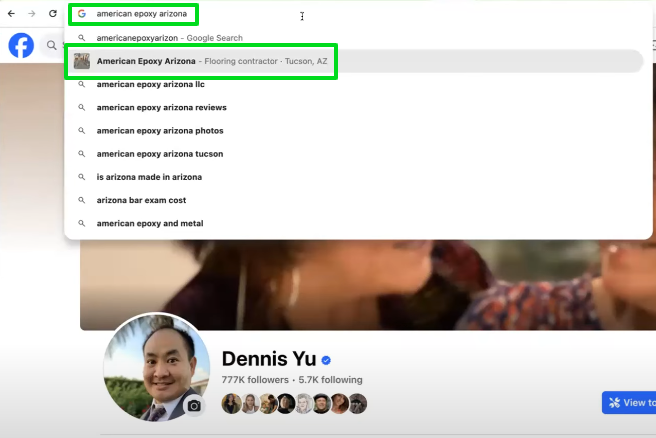
Next, the type-ahead search results appeared. People are asking about reviews and photos, so Google’s autocomplete tries to predict what you want before you even press enter.

This is her Google Business Profile, and the main reason for her growth is that American Epoxy Arizona delivers excellent work and has strong reviews—4.8 stars out of 169 reviews. Their presence on Facebook is less robust, and Yelp can be hit or miss, along with their social media. However, they’ve done a great job managing their marketing.
Even though their website ranks number one, it’s not driving much business. Their teams are doing such excellent work on-site that their online efforts, like Facebook ads, aren’t as effective.
It’s like having a Ferrari with a flat tire. When you deliver quality work and earn good reviews, you don’t need heavy marketing. Google and Facebook want to showcase businesses that truly deserve to rank high. For instance, if someone is searching for epoxy or concrete floors for their garage, Google will prioritize showing the best options.
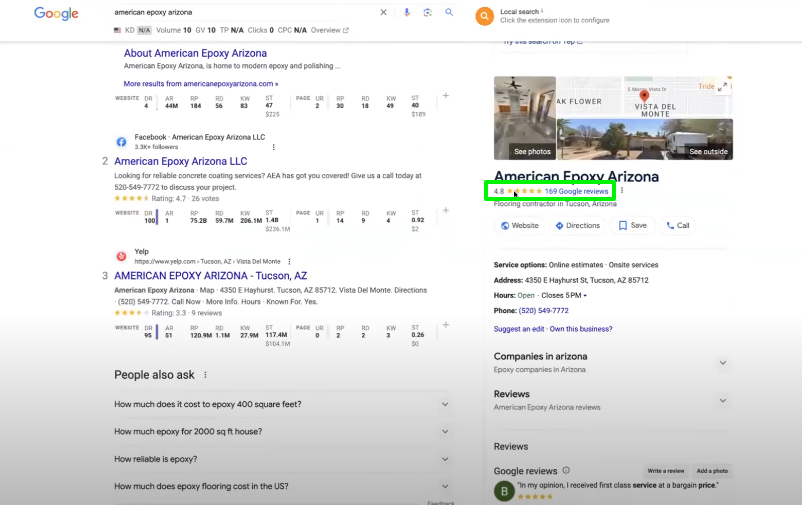
We’re now examining the keywords her website is ranking for. As of five hours ago, they jumped from nothing to position 6 for the keyword “epoxy flooring near me.” They’re ranking in eight areas, indicating they’re running ads.
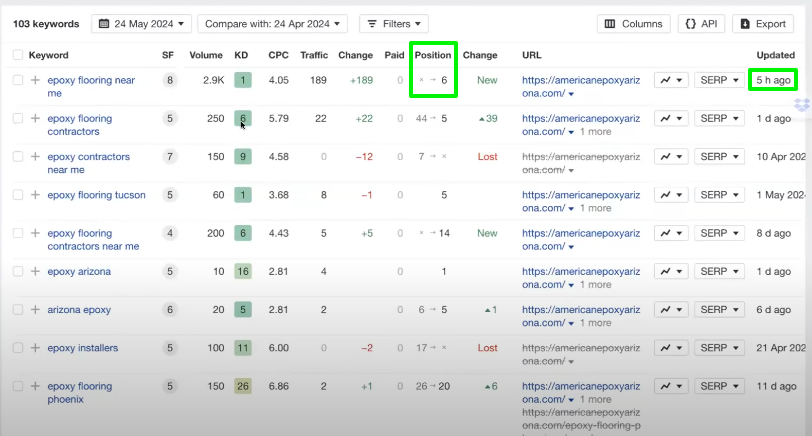
They’re in the 3-pack for local results, map results, mobile and desktop thumbnails, shopping results, and site links within their Google ads. This is impressive because most people only run Google ads on keywords, not realizing they can leverage all these rich snippets.
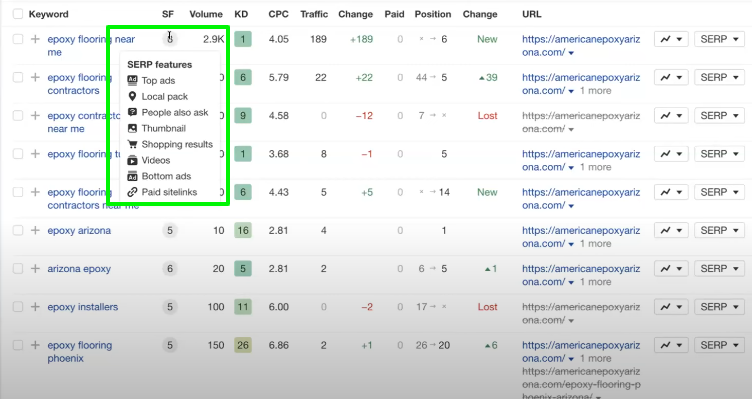
You might notice keywords like “epoxy installers” or “epoxy flooring contractors near me” fluctuating. This is normal, much like the stock market where values go up and down.
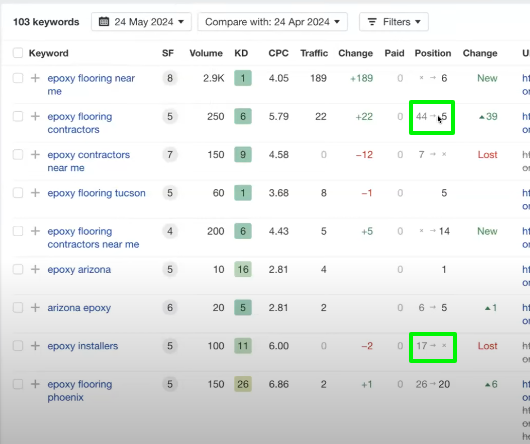
Looking at the website’s traffic history, it’s been inconsistent. Last summer was strong, but traffic dipped in the winter despite Tucson’s heat. However, from April to May, there’s been an uptick. This isn’t due to her efforts but rather Google’s updates. The “helpful content update” or March core update penalized websites using AI tools and spammy SEO tactics. These penalties benefited businesses that genuinely deliver on their promises and can prove it.

There have been 605 changes, and the quickest way to spend more money is by adding irrelevant keywords.
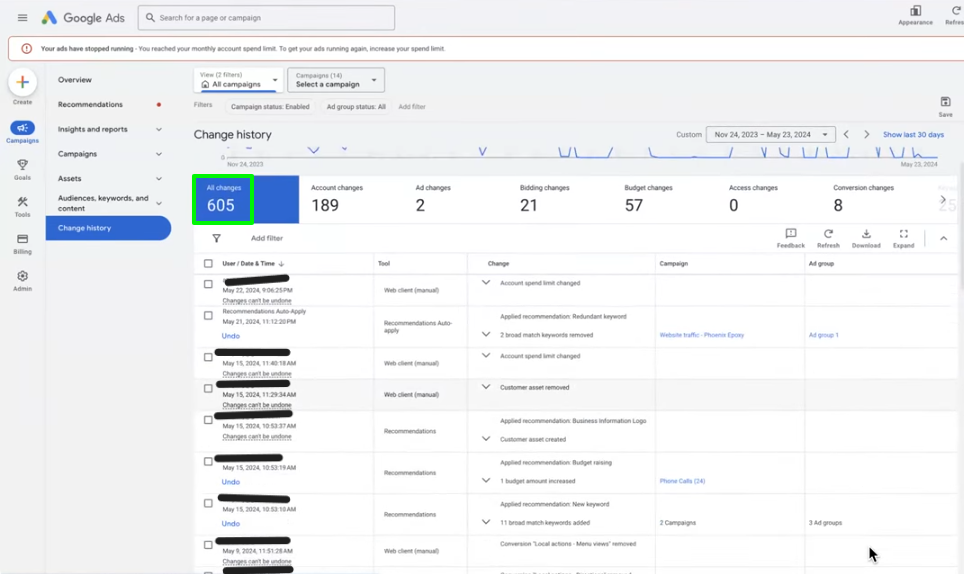
One of my favorite things to do is dive into Google Ads and Facebook Ads to see what’s been done. Often, when an agency has been running things and no one has touched it for months, we find nothing in the change history. But here, there are changes because she’s been making them herself.
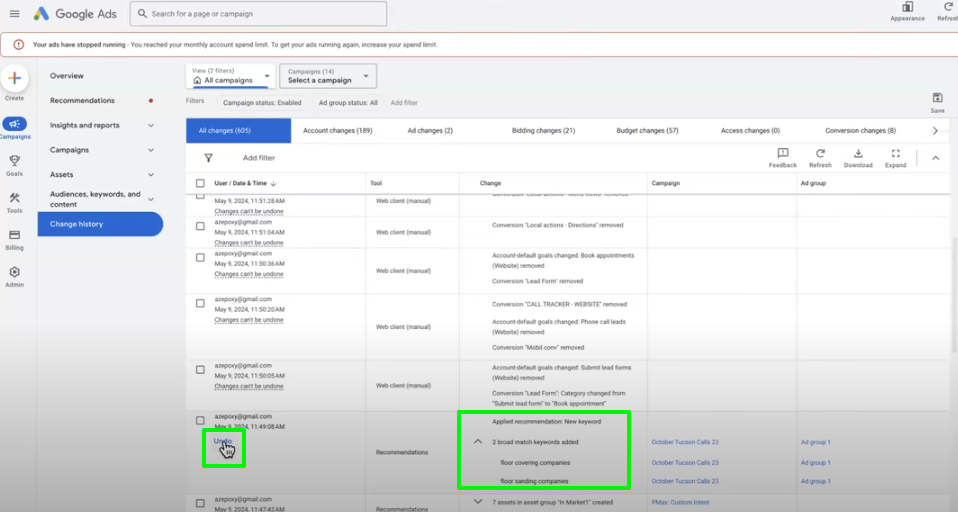
I can tell this is bad just from the naming conventions. Look at all these keywords—many are irrelevant to her business.
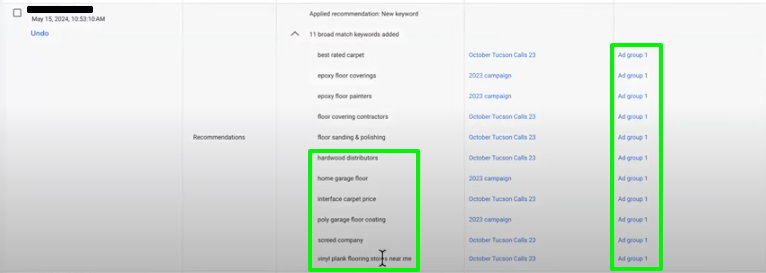
Often, a client brings us in alongside their agency, and while the agency tries to impress, we can see what’s really happening.
We hire many offshore people. For example, Rakesh from India makes a change, and we talk to the American account manager. But all the changes are done by someone in India. This isn’t a problem, but if the person you’re communicating with doesn’t understand what’s going on and is just a call center rep, you might as well talk directly to the Google rep.
Whoever is managing the account—you—needs to understand it like a mechanic knows how to fix a car. You can’t just be a salesperson, which is why the agency model often fails.
Her campaign structure is the culprit, so to check it, we’ll click on “Campaigns,” then select “Campaigns” again from the dropdown.
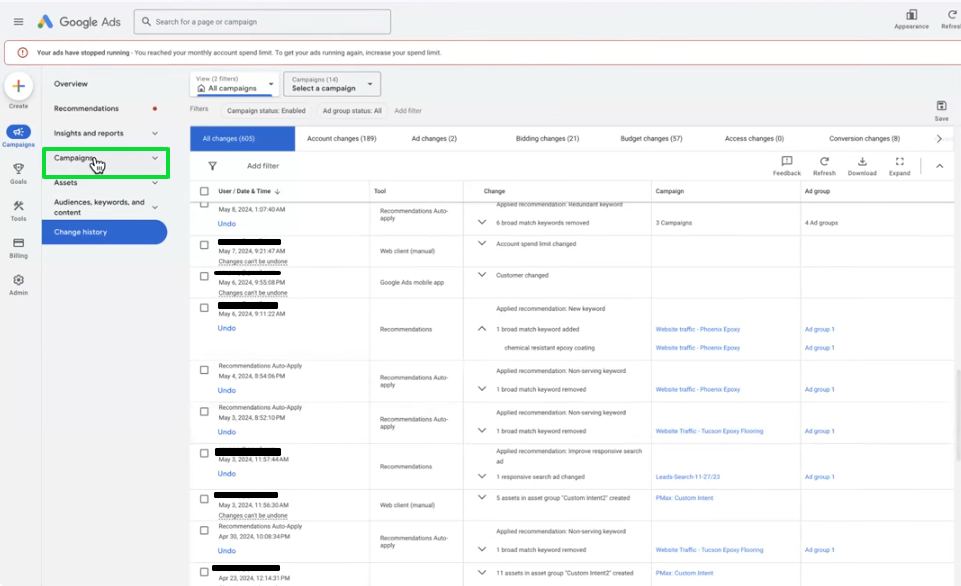

Then, you’ll sort by the cost column.
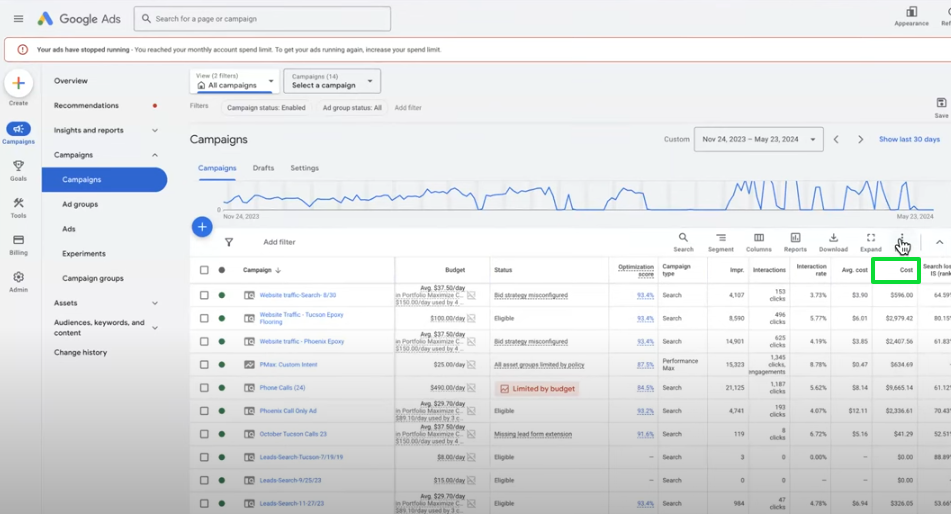
Instead of going through all 14 campaigns to check which ones are bleeding, we sort them by cost. Only 5 campaigns are actually spending money. We kill the bleeders and optimize the winners.
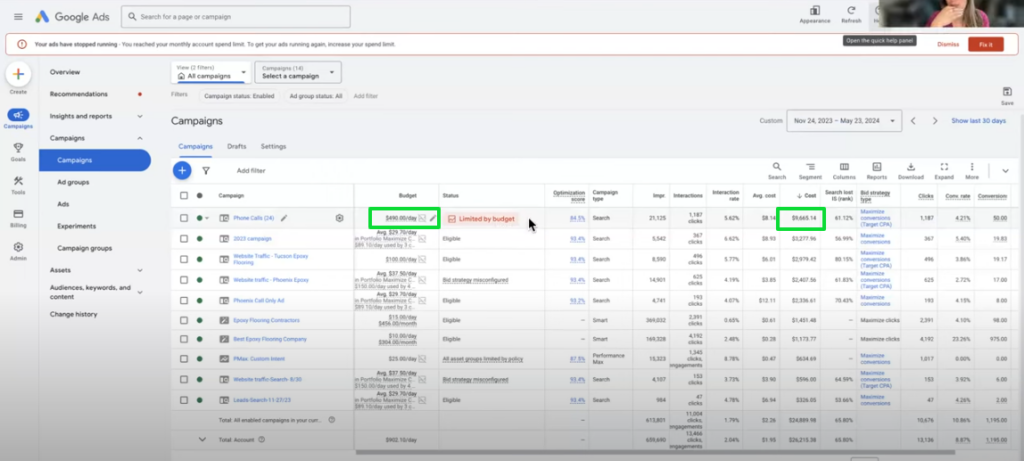
The first campaign is spending a third of her budget. Google says strategies to maximize conversions and tells you to spend more. However, instead of thinking the solution is turning the dial let’s fix it.
We click on the “Phone Calls (24)” campaign.
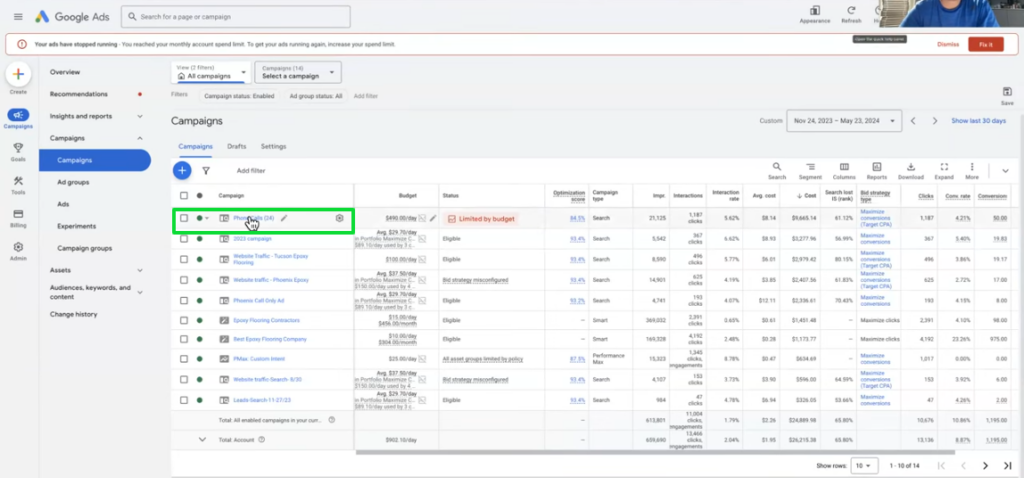
This only has one ad group called “ad group 1” inside of one campaign.
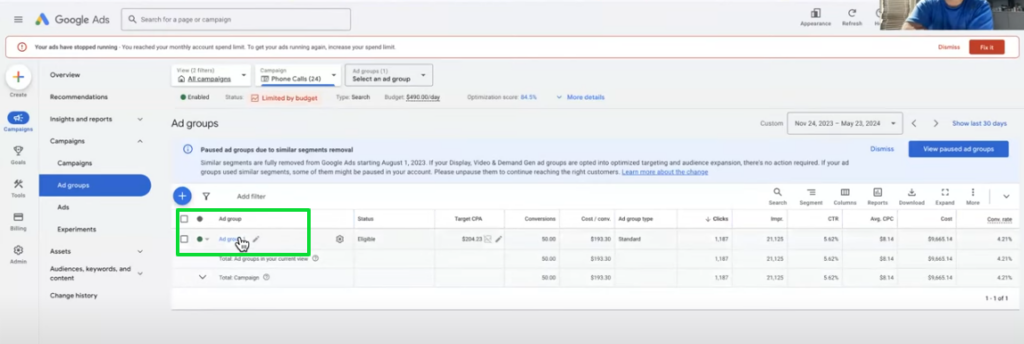
Since the beginning, Google had a structure of campaigns to ad groups to ads why have all of this complexity?
If you want to be a doctor and open up a body, you see all these organs. You can’t just discard them, thinking only the heart and lungs matter. All organs are essential.
The ad group is exactly what it says. It’s a way to group different ads together based on theme, context, or intent. Click on the ad group to see the keywords inside. Once you see this, it becomes obvious.
Someone looking to do their garage is different from someone wanting epoxy for their patio. An “Arizona epoxy” search could mean anywhere in Arizona, not just Phoenix. These keywords are related but not exactly the same.
There’s only one ad group here, and they have crammed all these random keywords into it, simply naming it “Ad Group One.”
When I see a name like that, it tells me right away—99 percent of the time—that nobody has organized this properly. I’ve done this thousands of times, this is like groundhog day for me. The moment I see “Ad Group One,” I already know what’s inside, even before I click on it.
The fundamentals of Google Ads are about matching keywords in groups that align with what the person is searching for. That’s the essence of what a search engine does. It’s obvious in hindsight, but you should share this with your concrete coating friends—they may not realize how they’ve been misled or misunderstood.
This is called an ad group. We go from the campaign to the ad group to the keyword. The ad group is a collection of ads, and the ad is what you show someone when they type in that keyword. For instance, if someone is searching for “industrial flooring” for a large project like a warehouse or trampoline park, you need an ad specifically tailored to that search intent. That’s what an ad group is for—you create a targeted message for each group.
Concrete coatings cover various services, and while epoxy is one form of it, each should have a unique message. You can’t use the same ad for all because they’re lumped into the same ad group. For example, you wouldn’t show an industrial flooring ad to someone looking for garage flooring—it just doesn’t connect.
How effective will this campaign structure be? Not very, right? That’s why it’s important to create multiple ad groups with appropriate names like “Garage,” “Industrial,” “Epoxy,” “Phoenix,” “Tucson,” etc. The ads tied to each group should match the search intent.
Let’s talk about epoxy. It’s too broad a term, and look what happened. This ad group spent $10,000, with 60% of that money going to “epoxy.” More than half your clicks and budget were spent on this one keyword. But were the calls generated by “epoxy” any good? You don’t know because everything is lumped together in one ad group. You need to separate them.
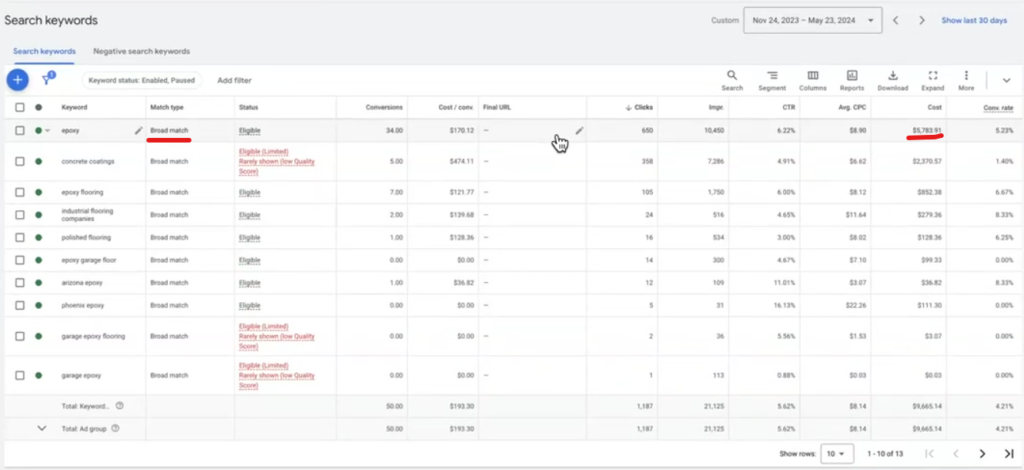
I’d put “Epoxy” in a separate ad group and avoid using a broad match. Instead, focus on more relevant keywords like “Epoxy garage flooring.” It’s more specific, has higher relevancy, and you’re willing to pay more for it because it’s worth more to you than just “Epoxy.”
I’ve done thousands of audits just like this one, which you can see on our BlitzMetrics YouTube channel. You can also buy one-on-one time with me to audit your website using MAA.
